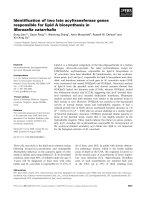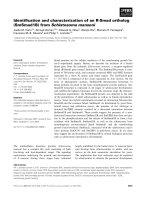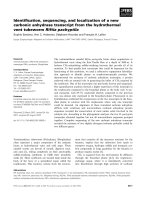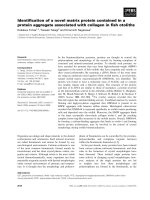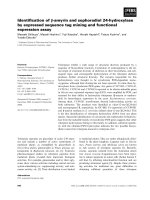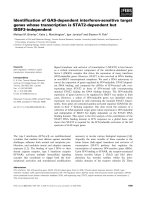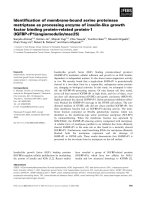Tài liệu Báo cáo Y học: Identification of a set of genes involved in the biosynthesis of the aminonucleoside moiety of antibiotic A201A from Streptomyces capreolus pdf
Bạn đang xem bản rút gọn của tài liệu. Xem và tải ngay bản đầy đủ của tài liệu tại đây (822.34 KB, 9 trang )
Identification of a set of genes involved in the biosynthesis of the
aminonucleoside moiety of antibiotic A201A from
Streptomyces
capreolus
Irene Saugar*, Eloı
´
sa Sanz*, Miguel A
´
ngel Rubio
†
, Juan Carlos Espinosa
‡
and Antonio Jime
´
nez
Centro de Biologı
´
a Molecular, Universidad Auto
´
noma, 28049 Madrid, Spain
A novel cosmid (pABC6.5) whose DNA insert from Strep-
tomyces capreolus, the A201A antibiotic producer, overlaps
the inserts of the previously reported pCAR11 and pCAR13
cosmids, has been isolated. These two latter cosmids were
known to contain the aminonucleoside antibiotic A201A
resistance determinants ard2 and ard1, respectively.
Together, these three cosmids have permitted the identifi-
cation of a DNA stretch of 19 kb between ard1 and ard2,
which should comprise a large region of a putative A201A
biosynthetic (ata) gene cluster. The sequence of the 7 kb
upstream of ard1 towards ard2 reveals seven consecutive
open reading frames: ataP3, ataP5, ataP4, ataP10, ataP7,
ata12 and ataPKS1. Except for the last two, their deduced
products present high similarities to an identical number of
counterparts from the pur cluster of Streptomyces alboniger
that were either known or proposed to be implicated in the
biosynthesis of the N
6
,N
6
-dimethyl-3¢-amino-3¢-deoxyade-
nosine moiety of puromycin. Because A201A contains this
chemical moiety, these ataP genes are most likely implicated
in its biosynthesis. Accordingly, the ataP4, ataP5 and
ataP10 genes complemented specific puromycin nonpro-
ducing Dpur4, Dpur5 and Dpur10 mutants of S. alboniger,
respectively. Amino acid sequence comparisons suggest that
ata12 and ataPKS1 could be implicated in the biosynthesis
of the
D
-rhamnose and a-p-coumaric acid moieties of
A201A. Further sequencing of 2 kb of DNA downstream of
ard1 has disclosed a region which might contain one end
of the ata cluster.
Keywords: aminonucleosides; A201A; ata cluster; Strepto-
myces capreolus; pur cluster.
Nucleoside antibiotics constitute an important group of
microbial secondary metabolites that include a variety of
structural modifications of nucleosides and nucleotides.
Nucleosides and nucleotides participate in essential bio-
chemical processes as cofactors, energy donors, secondary
messengers, etc. Hence, it is not surprising that known
nucleoside antibiotics have a wide range of modes of
action as antibacterial (puromycin), plant antifungal
(blasticidin S, mildiomycin), antiviral (oxetanocin, Ara-A),
antitumoral (oxanosine, neplanocin A), herbicidal (poly-
oxins), insecticidal (nikkomycins), inmunostimulative and
inmunosuppressive agents (bredinin) (reviewed in [1]).
A201A is one of these antibiotics, which is produced by
Streptomyces capreolus NRRL 3817. It is highly active
against Gram positive aerobic and anaerobic bacteria and
most Gram negative anaerobic species. In contrast, it has
a low toxicity for aerobic Gram negative bacteria, some
fungi and mammals [2]. Its chemical structure has been
reported (Fig. 1). It has the N
6
,N
6
-dimethyl-3¢-amino-3¢-
deoxyadenosine (aminonucleoside) moiety of puromycin
from Streptomyces alboniger. It also contains a polyketide
(a-methyl-p-coumaric acid) and an unsaturated furanose
moiety, which are closely related to similar structures
found in hygromycin A from Streptomyces hygroscopicus
[3,4]. These similarities suggest that certain enzymes, and
therefore the corresponding genes of the A201A biosyn-
thetic pathway, may be related to their counterparts of the
puromycin and hygromycin A biosynthetic pathways,
respectively.
The puromycin biosynthetic gene cluster (pur)from
S. alboniger is partially characterized. It has been expressed
in a regulated manner from a variety of plasmids in
Streptomyces lividans and Streptomyces griseofuscus.Its
complete nucleotide sequence, as well as additional bio-
chemical work, has led to the proposal of a puromycin
biosynthetic pathway that starts with ATP [5,6]. This pur
cluster comprises 10 open reading frames (ORFs), of which
pur3, pur4 and pur5 appear to encode monophosphatase,
aminotransferase, and N-methyltransferase activities,
respectively. In addition, pur7 and pur10 encode nudix
(NTP-pyrophosphohydrolase) and NAD-dependent ATP
dehydrogenase activities, respectively [7–9]. These five
proteins appear to be implicated in the biosynthesis of the
aminonucleoside moiety of puromycin, a structure also
present in A201A.
Correspondence to A. Jime
´
nez, Centro de Biologı
´
a Molecular
ÔSevero OchoaÕ, Universidad Auto
´
noma, Cantoblanco, 28049 Madrid,
Spain. Fax: + 34 91 3974799, Tel.: + 34 91 3978442,
E-mail:
Abbreviations: dA, deoxyadenosine; ORF, open reading frame;
PKS, polyketide synthetase; puromycin aminonucleoside,
N
6
,N
6
-dimethyl-3¢-amino-3¢-deoxyadenosine.
*Note: Both authors contributed equally to this work
Present address: Lawrence Berkeley National Laboratory,
Life Sciences Division, 1 Cyclotron Road, ms 84–171, Berkeley,
CA 94720, USA
àPresent address: Instituto de Investigaciones Biome
´
dicas ÔAlberto
SolsÕ (CSIC-UAM), Arturo Duperier 4, E-28029 Madrid (Spain)
(Received 9 July 2002, revised 6 September 2002,
accepted 13 September 2002)
Eur. J. Biochem. 269, 5527–5535 (2002) Ó FEBS 2002 doi:10.1046/j.1432-1033.2002.03258.x
In actinomycetes, it is well established that genes impli-
cated in antibiotic biosynthesis, including those encoding
self-resistance, are clustered [10,11]. Therefore, it may be
expected that genes involved in A201A biosynthesis in
S. capreolus are also clustered with those encoding resistance
conforming a hereafter named ata (for A two zero one A)
cluster. In this respect, cosmids containing two A201A
resistance determinants, ard1 and ard2 from S. capreolus,
were previously isolated and partially characterized [12,13].
Upstream (120 bp) of ard1, an incomplete ORF (named
hereafter ataP3) that would encode a monophosphatase was
found [13]. This putative activity would be a counterpart of
the pur3 gene product from the pur cluster [6]. This finding
suggests that, similarly to the pur cluster, next to this ORF
there should be additional genes encoding other proteins
implicated in the biosynthesis of the aminonucleoside moiety
of A201A. Here we report the sequencing of a total of
6946 bp, which include the ata genes most likely implicated
in the biosynthesis of this moiety of A201A. Evidence for the
functional identification of three of these genes is presented.
MATERIALS AND METHODS
Bacterial strains, plasmids, media and cultural
conditions
Streptomyces capreolus NRRL3817, the A201A producer
[3], Streptomyces lividans 66(1326) [14], Streptomyces albo-
niger ATCC12461, the puromycin producer [6], the non
producer mutant strain S. alboniger Dpur10 [8,9], Escheri-
chia coli DH5a [15] and E. coli HB101 [16] are described in
the indicated references. E. coli plasmids were ÔBluescriptÕ
SK (pBS; Stratagene), pUC18, pUC19 and pUO9090 (a
pUK21 derivative plasmid provided by Prof J. A. Salas)
[17–19]. Streptomyces vector pIJ702 and the nonoverlap-
ping cosmids pCAR11 and pCAR13 containing the A201A
resistance determinants ard2 and ard1, respectively (Fig. 2),
were described elsewhere [12–14]. pGM9, a replication
thermosensitive plasmid, was previously described [22].
Plasmid pFV8 is a pIJ702 derivative, which expresses a
puromycin N-acetyltransferase (Pac) activity and includes
pur5 from pur cluster [20,21]. pSEXP0.2, a pIJ702 derivative
plasmid carrying pur10 from pur (nucleotides 2611–4490)
was described in [8]. pSEXP4.2 is a pIJ702 derivative
plasmid carrying pur4 from pur (nucleotides 5986–8012) [9].
Plasmids pA2A10, pA2A5 and pA2A4 include BsmAI
(nucleotides 2613–4928), DdeI-HindII (nucleotides 5304–
6285) and PstI-NotI (nucleotides 3995–5863) fragments
from S capreolus into the SphI-SstI, SphI-BglII and SphI-
SstI replicon fragments of pIJ702, respectively (Figs 2 and
3). These three plasmids were constructed via pUC18.
To construct a S. alboniger Dpur4 mutant, a NotI
fragment from the pur cluster (nucleotides 3954–9039)
was isolated and then its nucleotides 6204 to 7359 were
deleted by substitution with a hyg gene that lacked a
transcription terminator. The resulting fragment only
contains the initial 67 bp and the final 68 bp of the pur4
coding sequence. It was inserted in plasmid pGM9. The
resulting construct was introduced, via S. lividans,into
S. alboniger. Several Dpur4 mutants were isolated as
described [22]. The correct genotype from several mutants
was assessed by Southern blotting (data not shown).
Similarly, a S. aboniger Dpur5 mutant was prepared,
except that in a SmaI fragment (nucleotides 6141–9163)
from pur a hyg gene was introduced to replace a SAM-
dependent methyltransferase domain (nucleotides 7522–
7899). Several Dpur5 mutants were isolated. Their correct
genotype was assessed by Southern blotting (data not
shown).
E. coli wasgrowninliquidoragarLB(Luria–Bertani)
[23]. In the presence of hygromycin B (50 lgÆmL
)1
), NaCl
was not added to this media. When required, ampicillin
was added to a final concentration of 100 lgÆmL
)1
.
Growth of S. capreolus took place in liquid media NE
(10 gÆL
)1
glucose, 2 gÆL
)1
yeast extract, 1 gÆL
)1
beef
extract, 2 gÆL
)1
casaminoacids, pH adjusted to 7.0 with
KOH), S containing 2 m
M
MgSO
4
[5], or TSB [14]. As
solid media, R5 [14], S containing 5 m
M
MgSO
4
[5] or
MEY (20 gÆL
)1
agar, 10 gÆL
)1
maltose, 4 gÆL
)1
yeast
extract and 0.001% CoCl
2
, pH adjusted to 7.0 with
NaOH) supplemented with sterile 8 m
M
Ca(NO
3
)
2
before
plating were used. S. lividans was grown in either NE or
YEME plus 34% sucrose and 5 m
M
MgCl
2
[14]. S. albo-
niger was grown in liquid S media [5] containing 5 m
M
MgSO
4
. When required, thiostrepton was used at a final
concentration of 10 lgÆmL
)1
and 25 lgÆmL
)1
in liquid
and agar media, respectively, whereas hygromycin B was
added to a final concentration of 200 lgÆmL
)1
.
Transformation of E. coli and S. lividans was performed
according to Hopwood et al. [14]. Transformation of
S. alboniger was performed according to Pigac et al.[24]
or to a modification of Hopwood et al.[14].
Nucleic acids methodology
Plasmid and total DNA from Streptomyces and E. coli
were prepared as described [14]. As S. capreolus is
lysozyme resistant, total DNA extraction was carried out
by freezing mycelium with liquid nitrogen and grinding in
a mortar with a pestle. The resulting powder was
resuspended in 10.3% sucrose, 25 m
M
EDTA and 25 m
M
Tris pH 8; then SDS was added to final concentration of
Fig. 1. Chemical structure of A201A and
puromycin.
5528 I. Saugar et al.(Eur. J. Biochem. 269) Ó FEBS 2002
1%. From this point, the procedure described in Hop-
wood et al. [14] was followed. DNA sequencing was made
by the dideoxy-chain termination method [25] using the
Amplitaq dye-terminator sequencing system (Perkin Elmer)
on an automated DNA sequencer (Applied Biosys-
tems, model 377). Forward, reverse and custom-made
oligonucleotides (Isogen Bioscience) were used as required.
DNA fragments used as probes were labelled using
[a-
32
P]dCTP following the random oligonucleotide primers
procedure [26]. Southern blot hybridizations were carried
out as described [26] using Zeta-Probe GT membranes
(Bio-Rad).
A S. capreolus library [13] was screened by colony
hibridization [26] on nitrocellulose Hybond-N
TM
mem-
branes (Amersham) using as probes DNA fragments from
the ends of the inserts of cosmids pCAR11 and pCAR13.
This permitted the isolatatiom of cosmid pABC6.5, which
overlaps these two cosmids (Fig. 2). Appropriate restriction
fragments from pABC6.5 and pCAR13 were subcloned in
pBS and then sequenced.
Computer analysis
Current methodology was employed to analyze nucleotide
and amino acid sequences [27–29].
Determination of puromycin
Puromycin was extracted from culture filtrates with
chloroform as described elsewhere [5]. It was identified
by thin layer chromatography (TLC) on Silica Gel60 F
254
(Merck, Darmstadt) using ethylacetate/methanol (3 : 1,
v/v) as solvent [5]. Plates were examined under UV light
(254 nm). Further identification and quantification
of puromycin were achieved by a Pac enzymatic assay
[21].
Preparation of 3¢-amino-3¢-deoxyadenosine
3¢-amino-3¢-deoxyadenosine was obtained from Helmin-
thosporium sp. ATCC20154 as described [30], except that
starch was used instead of cerellose.
Chemical complementation of
S. alboniger
Dpur4
mutants
To study complementation of S. alboniger Dpur4 mutants
with 3¢-amino-3¢-deoxyadenosine, S medium cultures
(5 mL) either in the presence or absence of 30 lgÆmL
)1
3¢-amino-3¢-deoxyadenosine were inoculated with spores of
the different strains. Incubation took place on a rotary
Fig. 2. Restriction map of the inserts from several cosmids and gene organization. DNA fragments sequenced in this work are in black boxes, whereas
those sequenced previously are in dashed boxes. Cosmids pCAR11 and pCAR13, which contain the A201A resistant determinants ard2 and ard1,
respectively, are modified from Barrasa et al. [12,13]. As a comparison, the gene organization of the pur cluster is shown at the bottom of this figure.
The asterisks indicate restriction sites that are not unique in the drawn DNA fragments. They are referred to in the text.
Ó FEBS 2002 Aminonucleoside A201A biosynthetic genes (Eur. J. Biochem. 269) 5529
shaker at 30 °C. Puromycin production was then deter-
mined in culture filtrates by a Pac assay [21].
Nucleotide sequence accession number
The sequence reported here was submitted to the EMBL
database as a modification of accession number X84374.
RESULTS
The
ata
genes and their deduced proteins
Cosmid pABC6.5, which overlaps cosmids pCAR11 and
pCAR13, was isolated as indicated under Materials and
methods. These latter cosmids contain the A201A resistance
determinants ard2 and ard1, respectively [12,13] (Fig. 2).
Together the three cosmids define a continuous stretch of
DNA of approximately 50 kb, which might include most of
the ata cluster. In this respect, upstream of the ard1
resistance gene we detected seven complete ORFs. Of these,
six were located immediately upstream of and oriented in
the same direction of transcription as ard1,whereasthe
seventh one was in the opposite orientation (Figs 2 and 3).
The deduced products of five of these contiguous ORFs
showed similarities with several products from the pur
cluster of S. alboniger [6]. They were accordingly named
ataP3, ataP5, ataP4, ataP10 and ataP7. The two additional
ones were named ata12 and ataPKS1 (Figs 2 and 3). All
shared a codon usage and a G+C content at the third
position typical of Streptomyces [28]. Other characteristics
of these ORFs, including putative ribosomal binding sites,
)10 and )35 regions, consensus sequences, etc., are
indicatedinFig.3.
ataP3, ataP4,andataP5 encode peptides (AtaP3,
AtaP4 and AtaP5) that are highly similar to Pur3, Pur4
and Pur5 from the pur cluster (Table 1) [6]. These latter
Fig. 3. Nucleotide and deduced amino acid
sequences of S. capreolus DNA. (A) Sequence
of the region upstream of ard1 (Fig. 2). The
deduced amino acid products are indicated in
the one-letter code under the DNA sequence.
Possible ribosomal binding sites are indicated
by dotted lines. Putative translation initiation
and termination codons are in bold letters.
The start and direction of each ORF are
indicated by horizontal arrows and named
accordingly. Putative )10 and )35 regions of
ata12 and ataPKS1 are overlined. Restriction
sites with asterisk are not unique in the
sequence. Proposed motives of the putative
proteins are boxed. Small letters correspond to
previously reported sequences, which were
confirmed here [12,13].
5530 I. Saugar et al.(Eur. J. Biochem. 269) Ó FEBS 2002
sequences were proposed to have phosphatase, amino-
transferase and methyltransferase activities, respectively
[6]. Therefore, similar activities should be shared by their
ata cluster counterparts. In addition, ataP7 and ataP10
encode peptides (AtaP7 and AtaP10) that are highly
similar to Pur7 and Pur10 from the pur cluster,
respectively (Table 1) [6]. Whereas Pur7 has a pyrophos-
phatase activity, which converts 3¢-amino-3¢-dATP into
3¢-amino-3¢-dAMP and pyrophosphate [7], Pur10 is an
NAD-dependent ATP dehydrogenase [6,8]. Consequently,
AtaP7 and AtaP10 should display similar activities,
respectively.
ata12 encodes a 340 residue protein (Ata12) that shows a
high similarity to GDP-
D
-mannose and other hexose
dehydratases (data not shown) (Fig. 3). A variety of these
enzymes synthesize 4-keto-6-deoxy-GDP-
D
-mannose, a key
intermediate in the biosynthesis of many deoxyhexoses as
GDP-
D
-rhamnose [31,32], which is a moiety of A201A.
Upstream of ata12 we found ataPKS1, which is transcribed
in the opposite orientation (Figs 2 and 3). ataPKS1 encodes
a putative peptide of 436 residues that contains an
acyltransferase domain highly similar to that of the type I
(single multifunctional enzymes) and type II (multienzyme
systems) polyketide synthetases (PKS; data not shown)
[33,34]. In contrast, its similarity to type III PKSs, which
lack this domain, is scant. This domain promotes the
binding of the acyl-CoA initiation unit to the ketosynthetase
domain of the PKSs for polyketide biosynthesis [35].
Therefore, AtaPKS1 could be an acyltransferase, which
should be implicated in the biosynthesis of the A201A
polyketide moiety.
A 2064-bp fragment-3¢ of ard1 was also sequenced
(Fig. 2; data not shown). The719 bp immediately down-
stream of the ard1 stop codon did not contain putative
ORF(s). This might suggest that this region is an end of
the ata cluster. However, a significant stem loop, which
could suggest a transcriptional termination site, was not
detected. Downstream of this region, two additional
putative ORFs with typical Streptomyces codon usage
were found. Because they might not belong to the ata
Fig. 3. (Continued).
Table 1. Similarity and identity among the deduced products of ata and
pur genes.
ORF Residues % Similarity % Identity
AtaP3/ 268
Pur3 273 76.8 72.9
AtaP4/ 427
Pur4 429 80.5 74.9
AtaP5/ 228
Pur5 228 73.1 65.6
AtaP7/ 172
Pur7 152 70.6 65.0
AtaP10/ 361
Pur10 338 61.3 55.2
Ó FEBS 2002 Aminonucleoside A201A biosynthetic genes (Eur. J. Biochem. 269) 5531
cluster, they were provisionally named ORFA and ORFB
(Fig. 2). The deduced amino acid sequence of ORFA (294
residues) showed no significant similarities with sequences
present in data bases. The deduced amino acid sequence
of ORFB (108 residues) is highly similar to thioredoxins
(data not shown), which are general disulphide oxido-
reductases [36].
Ata
genes complement puromycin nonproducing
S. alboniger
mutants
Identification of the function of a gene product may be
achieved by a variety of assays including gene complemen-
tation of the relevant mutant in the organism under study or
of a similar gene mutant in a different organism. In these
respects, S. capreolus, despite thorough attempts, was not
amenable to the recombinant DNA techniques that are
employed to prepare specific mutants. Therefore, we used
the latter approach to identify the function of several ataP
genes by analyzing the complementation of S. alboniger
strain mutants for pur10, which was previously described
[8,9], and those for pur4 and pur5, which were obtained in
this work (Materials and methods). These mutants contain
partial deletions in the relevant genes and are defective in
puromycin production (Table 2) [8,9]. Plasmids pFV8,
pSEXP4.2 and pSEXP0.2 (pIJ702 derivatives described in
Materials and methods) containing pur5, pur4 and pur10,
respectively, were used for the homologous complementa-
tion assays. The ataP5, ataP4 and ataP10 genes were also
independently inserted in the pIJ702 vector and the resulting
plasmids pA2A5, pA2A4 and pA2A10, respectively
(Materials and methods), were used for heterologous
complementation. All gene insertions were downstream of
thetyrosinasegene(mel)promoterofpIJ702.Thethree
S. alboniger mutant strains were transformed with the
corresponding plasmids. As controls, S. alboniger and these
three mutant strains were transformed with pIJ702. The
three S. alboniger mutants regained the ability to produce
puromycin when either the corresponding deleted pur gene
or the heterologous ataP gene was present (Fig. 4). In
addition, puromycin production was quantified in culture
filtrates by means of the highly specific Pac reaction [20,21].
The results (Table 2) confirmed the complementation and
the regaining of production by the mutant strains. These
findings clearly indicated the correlation between sequence
similarities and conservation of enzymatic functions of
AtaP10/Pur10, AtaP5/Pur5 and AtaP4/Pur4. Curiously,
puromycin production in the complemented mutants is only
approximately one-third that from the S. alboniger (pIJ702)
control (Table 2). It is possible that the alteration of the high
copy number vector by the insertion of the different genes is
not neutral for the physiology, including puromycin
production, of the transformants.
Chemical complementation of
S. alboniger
Dpur4
mutants
Complementation of metabolite nonproducing mutants
with putative intermediates is also a widespread experimental
approach to establish specific biosynthetic steps. In the case
of the aminonucleoside moiety of A201A and puromycin,
3¢-amino-3¢-dA could be an intermediate. The availability of
S. alboniger Dpur4 mutants, which could not perform
3¢-amino addition, as well as 3¢-amino- 3¢-dA, offered an
opportunity to test this possibility. Therefore,this compound
was used in a complementation assay with two S. alboniger
Table 2. Gene complementation of several S. albon iger mutants.
Puromycin production from 56 h cultures was quantified as indicated
in Materials and methods.
Strain
Puromycin production
(lgÆmL
)1
)
S. alboniger wt 3.29
S. alboniger (pIJ702) 1.68
S. alboniger Dpur10 (pIJ702) 0.03
S. alboniger Dpur10 (pSEXP0.2) 0.89
S. alboniger Dpur10 (pA2A10) 0.95
S. alboniger Dpur4 (pIJ702) 0.02
S. alboniger Dpur4 (pSEXP4.2) 0.32
S. alboniger Dpur4 (pA2A4) 0.22
S. alboniger Dpur5 (pIJ702) 0.00
S. alboniger Dpur5 (pFV8) 0.35
S. alboniger Dpur5 (pA2A5) 0.46
Fig. 4. Analysis of puromycin production by TLC. Chloroform extracts
from culture filtrates were obtained and then developed by TLC as
indicated under Materials and methods. Lanes 1 and 2, puromycin and
N-acetylpuromycin (12 nmol each); lanes 3, 4, 5 and 6 S alboniger
(pIJ702), S. alboniger Dpur10 (pIJ702), S. alboniger Dpur10
(pSEXP0.2) and S. alboniger Dpur10 (pA2A10), respectively; lanes 7, 8
and 9 S alboniger Dpur4 (pIJ702), S. alboniger Dpur4 (pSEXP4.2)
and S. alboniger Dpur4 (pA2A4), respectively; lanes 10, 11 and
12, S. alboniger Dpur5 (pIJ702), S. alboniger Dpur5 (pFV8) and
S. alboniger Dpur5 (pA2A5), respectively.
Table 3. Complementation of S. alboniger Dpur4 mutants with 3¢-ami-
no-3¢-dA. Puromycin production from 63 h cultures was quantified as
indicated in Materials and methods. + and – indicate the presence or
absence of drug in the culture media, respectively.
Strain 3¢-amino-3¢-dA
Puromycin production
(lgÆmL
)1
)
S. alboniger wt – 6.24
S. alboniger wt + 5.97
S. alboniger Dpur4.1 – 0.01
S. alboniger Dpur4.1 + 5.26
S. alboniger Dpur4.2 – 0.01
S. alboniger Dpur4.2 + 4.84
5532 I. Saugar et al.(Eur. J. Biochem. 269) Ó FEBS 2002
Dpur4 mutants. The results indicated that this mutation was
clearly complemented by 3¢-amino-3¢-dA, which suggested
that it is an intermediate of the aminonucleoside moiety of
puromycin and, consequently, A201A (Table 3). In contrast,
the S. alboniger Dpur5 mutant was not complemented by
this substrate (data not shown), which is in agreement
with the proposed encoded activity from pur5.
DISCUSSION
In Actinomycetes, the antibiotic biosynthetic gene clusters
generally comprise a single stretch of DNA, which includes
the genes for self-resistance, enzymatic activities and regu-
lation. In this work, a fragment of at least 19 kb from
S. capreolus, which is comprised between two genes (ard1
and ard2) that determine resistance to the antibiotic A201A
[12,13] has been found to include a number of genes of its
biosynthetic (ata) gene cluster. Downstream of ard1 there
seems to be one end of this cluster (Fig. 2). Indeed, this
region contains a sequence of 719 residues with apparently
noncoding potential, which is continued by two putative
coding regions, one with no similarity to known sequences
and the other with similarity to a group of enzymes
(thioredoxins) that most likely do not play a role in A201A
biosynthesis. In contrast, upstream of ard1 there are six
contiguous coding sequences with identical orientation
(Figs2and3A).Ofthese,five(ataP3, ataP5, ataP4, ataP10
and ataP7) are highly similar to known or putative genes
that are known or proposed to be implicated in the
biosynthesis of the aminonucleoside moiety of puromycin
[6–8]. Interestingly, their organization is identical to that of
the pur cluster, with the exception of pur6, which is absent
from the S. capreolus genome (Fig. 2; data not shown).
These findings are not surprising given the structural
homology of A201A and puromycin (Fig. 1). Curiously,
the ataP10 gene lacks a TTA codon, which is present in the
pur10 gene and seems to play a role in the expression of the
pur cluster [6,37]. Concerning the enzymatic activities
encoded by these ataP genes, we propose that they should
be identical to the activities encoded by their counterparts
from the pur cluster. Indeed, our gene-complementation
experiments with the relevant S. alboniger disruption
mutants indicate that the ataP5, ataP4 and ataP10 genes
from the ata cluster are implicated in functions identical to
those of the similar genes of the pur cluster. In Actinomyc-
etes, this approach has led to the functional characterization
of genes implicated in the biosynthesis of a variety of
antibiotics for which mutants in the producing strains were
not available. Thus, complementation of Streptomyces
galilaeus mutants blocked in anthracyclines production
has led to the study of genes implicated in nogalamycin
biosynthesis from Streptomyces nogalacter [38,39]. Simi-
larly, complementation experiments carried out with
blocked mutants of Saccharopolyspora erythraea,the
erythromycin-producing organism, has permitted the isola-
tion of Streptomyces antibioticus genes implicated in
oleandomycin biosynthesis [40].
Gene analyses and enzymatic assays suggest that the
biosynthetic pathways of the aminonucleoside moieties of
A201A and puromycin start from ATP [6]. This metabolite
should be converted into 3¢-keto-3¢-didehydroATP by the
NAD-dependent ATP dehydrogenase AtaP10/Pur10 [8]
(Fig. 5). Although the product of this reaction could not be
isolated due to its extreme instability, the formation of a-3¢-
ketone derivative should be necessary for the action of the
putative transaminases AtaP4/Pur4 [41] to give rise to
3¢-amino-3¢-dATP. This intermediate is a strong inhibitor of
RNA polymerase, which therefore should be detoxified by
the nudix (housekeeping) pyrophosphatases Pur7/AtaP7 to
produce a nontoxic-3¢-amino-3¢-dAMP [42]. Indeed, this
detoxification was observed to take place in vitro [7]. This
latter intermediate might be dephosphorylated by the
putative monophosphatases AtaP3/Pur3. This possibility
is strongly supported by our finding that puromycin
nonproducing S. alboniger Dpur4 mutants are complemen-
ted by 3¢-amino-3¢-dA. Alternatively, this compound could
be5¢-phosphorylated by a putative adenosine kinase, as it
happens in intact Ehrlish ascites cells [42]. However, to our
knowledge no such activity has been described in prokary-
otes and we were unable to detect the relevant gene in the
known Streptomyces coelicolor genome. In addition,
3¢-amino-3¢-dA is tyrosinylated at the 3¢-amino group by
Pur6 from S. alboniger to produce tridemethyl-puromycin,
which could be the next step in puromycin biosynthesis
(M.A.Rubioet al. in preparation). Concerning dimethy-
lation at N
6
, which would be performed by the putative
SAM-dependent methyltransferases Pur5/AtaP5, it is not
yet known on which intermediate it takes place. Therefore,
the work presented here and elsewhere [6–8] suggests that
ataP3/pur3, ataP4/pur4, ataP5/pur5, ataP7/pur7 and
ataP10/pur10 are responsible for synthesizing the aminonu-
cleoside moiety of A201A and puromycin by S. capreolus
and S. alboniger, respectively.
Considering that most, if not all, of the genes between
ard1 and ard2 are part of the ata cluster, ata12 and ataPKS1
should also pertain to it. Further sequencing of the ata
cluster could provide an insight into the biosynthetic
pathway of the other moieties of A201A and provide
probes which may be useful to identify genes of the
hygromycin A biosynthetic gene cluster of S. hygroscopicus.
ACKNOWLEDGEMENTS
We thank A. Martı
´
n for expert technical assistance. This work was
supported by grants BIO096-1168-C02-02 and BIO1999-0959 of the
Comisio
´
n Interministerial de Ciencia y Tecnologı
´
a. We also thank the
Fundacio
´
nRamo
´
n Areces for an institutional grant to the Centro de
Biologı
´
a Molecular ÔSevero OchoaÕ.
Fig. 5. Schematic representation of the puta-
tive biosynthetic pathway of the 3¢-amino-3¢-
deoxyadenosine moiety of A201A and puro-
mycin.
Ó FEBS 2002 Aminonucleoside A201A biosynthetic genes (Eur. J. Biochem. 269) 5533
REFERENCES
1. Isono, K.J. (1988) Nucleoside antibiotics: structure, biological
activity and biosynthesis. J. Antibiot. 41, 1711–1739.
2. Ensminger, P.W. & Wright, W.E. (1976) A201A, a new antibiotic
produced by Streptomyces capreolus. II. Biological studies. Abst.
16th Intersci. Conference Antiomicrob. Agents Chemother. 63.
3. Kirst, H.A., Dorman, D.E., Occolowitz, J.L., Jones, N.D.,
Paschal, J.W., Hamill, R.L. & Szymanski, E.F. (1985) The struc-
ture of A201A, a novel nucleoside antibiotic. J. Antibiot. 38,
575–586.
4. Kakinuma, K., Kitahara, S., Watanabe, K., Sakagami, Y. &
Fukuyasu, T. (1976) On the structure of hygromycin. The location
of a methylene substituent and the anomeric configuration of the
arabino-hexoside moiety. J. Antibiot. 29, 771–773.
5. Lacalle, R.A., Tercero, J.A. & Jime
´
nez, A. (1992) Cloning of the
complete biosynthetic gene cluster for an aminonucleoside anti-
biotic puromycin, and its regulated expression in heterologous
hosts. EMBO J. 11, 785–792.
6. Tercero, J.A., Espinosa, J.C., Lacalle, R.A. & Jime
´
nez, A. (1996)
The biosynthetic pathway of the aminonucleoside antibiotic puro-
mycin, as deduced from the molecular analysis of the pur cluster of
Streptomyces alboniger. J. Biol. Chem. 271, 1579–1590.
7. Espinosa, J.C., Tercero, J.A., Rubio, M.A. & Jime
´
nez, A. (1999)
The pur7 gene from the puromycin biosynthetic pur cluster of
Streptomyces alboniger encodes a nudix hydrolase. J. Bacteriol.
181, 4914–4918.
8. Rubio, M.A., Espinosa, J.C., Tercero, J.A. & Jime
´
nez, A. (1998)
The Pur10 protein encoded in the gene cluster for puromycin
biosynthesis of Sreptomyces alboniger is an NAD-dependent ATP
dehydrogenase. FEBS Lett. 437, 197–200.
9. Rubio, M.A. (1998) Estudio de los genes implicados en los pasos
iniciales de la ruta de biosı
´
ntesis de puromicina en Streptomyces
Alboniger, PhD Thesis, Universidad Auto
´
noma de Madrid,
Spain.
10. Martı
´
n, J.F. & Liras, P. (1989) Organization and expression of
genes involved in the biosynthesis of antibiotics and other sec-
ondary metabolites. Annu. Rev. Microbiol. 43, 173–206.
11. Seno, E.T. & Baltz, R.H. (1989) Structural organization and
regulation of antibiotic biosynthesis and resistance genes in Acti-
nomycetes. In Regulation of Secondary Metabolism in Actino-
mycetes (Shapiro, S., ed.), pp. 1–48. CRC. Boca Raton, Florida,
USA.
12. Barrasa, M.I., Tercero, J.A. & Jime
´
nez, A. (1997) The aminonu-
cleoside antibiotic A201A is inactivated by a phosphotranferase
activity from Streptomyces capreolus NRRL 3817, the producing
organism. Eur. J. Biochem. 245, 54–63.
13. Barrasa,M.I.,Tercero,J.A.,Lacalle,R.A.&Jime
´
nez, A. (1995)
The ard1 gene from Streptomyces capreolus encodes a polypeptide
of the ABC-transporters superfamily which confers resistance
to the aminonucleoside antibiotic A201A. Eur. J. Biochem. 228,
562–569.
14. Hopwood, D.A.M.J., Bibb, K.F., Chater, T., Kieser, C.J., Bruton,
H.M., Kieser, D.J., Lydiate, C.P., Smith, J.M., Ward, J.M. &
Schrempf, H. (1985) Genetic Manipulation of Streptomyces. A
Laboratory Manual. John Innes Foundation, Norwich, England.
15. Hanahan, D. (1985) Techniques for transformation of E. coli.In:
DNA Cloning: a Practical Approach (Glover, D.M., ed.), pp. 109–
136. IRL Press, Oxford, United Kingdom.
16. Bolı
´
var, F. & Backman, K. (1979) Plasmids Escherichia coli
cloning vectors. Meth. Enzymol. 68, 245–267.
17. Norrander, J., Kempe, T. & Messing, J. (1983) Construction
of improved M13 vectors using oligodeoxynucleotide-directed
mutagenesis. Gene 26, 101–106.
18. Yanisch-Perron, C., Vieira, J. & Messing, J. (1985) Improved M13
phage cloning vectors and host strains: nucleotide sequences of the
M13mp18 and pUC19 vectors. Gene 33, 103–119.
19. Vieira,J.&Messing,J.(1991)NewpUC-derivedcloningvectors
with different selectable markers and DNA replication origins.
Gene 100, 189–194.
20. Vara, J., Malpartida, F., Hopwood, D.A. & Jime
´
nez, A. (1985)
Cloning and expression of a puromycin N-acetyl transferase gene
from Streptomyces alboniger, Streptomyces lividans and Escher-
ichia coli. Gene 33, 197–206.
21. Vara, J., Pe
´
rez-Gonza
´
lez, J.A. & Jime
´
nez, A. (1985) Biosynthesis
of puromycin by Streptomyces alboniger: characterization of
puromycin N-acetyltransferase. Biochemistry 24, 8074–8081.
22. Muth,G.,Nubbaumer,B.,Wohlleben,W.&Pu
¨
hler, A. (1989) A
vector system with temperature-sensitive replication for gene dis-
ruption and mutational cloning in streptomycetes. Mol. General
Genet. 219, 341–348.
23. Miller, J.F. (1992) A Short Course in Bacterial Genetics. A
Laboratory Manual and Handbook for Escherichia coli and Related
Bacteria. Cold Spring Harbor Laboratory Press, Cold Spring
Harbor, New York.
24. Pigac, J. & Schrempf, H. (1995) A simple and rapid method of
transformation of Streptomyces rimosus R6 and other Strepto-
mycetes by electroporation. Appl. Environ. Microbiol. 61, 352–356.
25. Sanger, F., Nicklen, S. & Coulson, A.R. (1977) DNA sequencing
with chain-terminating inhibitors. Biotechnology 24, 104–108.
26. Sambrook, K.J., Fritsch, E.F. & Maniatis, T. (1989) Molecular
Cloning. A Laboratory Manual, 2nd edn. Cold Spring. Harbor
Laboratory Press, Cold Spring Harbor, New York.
27. Devereux,J.,Haeberli,P.&Smithies,O.(1984)Acomprehensive
set of sequence analysis programs for the VAX. Nucl. Acids Res.
12, 387–395.
28. Wright, F. & Bibb, M.J. (1992) Codon usage in the G+C-rich
Streptomyces genome. Gene 113, 55–65.
29. Marck, C. (1991) Strider. Centre d’Etudes de Saclay, Gif-Sur-
Yvette, Cedex, France.
30. Gerber, N. & Chevalier, H.A. (1962) 3¢-amino-3¢-deoxyadenosine,
an antitumor agent from Helmintosporium sp. J. Org. Chem. 27,
2736–1732.
31. Andrianopoulos, K., Wang, P.L. & Reeves, P.R. (1998) Identifi-
cationofthefucosesynthetasegeneinthecolanicacidgenecluster
of Escherichia coli K-12. J. Bacteriol. 180, 998–1001.
32. Kneidinger, B., Graninger, M., Adam, G., Puchberger, M.,
Kosma, P., Zayni, S. & Messner, P. (2001) Identification of two
GDP-6-deoxy-
D
-lyxo-4-hexulose reductases synthesizing GDP-
D
-
rhamnose in Aneurinibacillus thermoaerophilus L420–91T. J. Biol.
Chem. 276, 5577–5583.
33. Hopwood, D.A. (1997) Genetic contributions to understanding
polyketide synthases. Chem. Rev. 97, 2465–2498.
34. Grimm, A., Madduri, K., Ali, A. & Hutchinson, C.R. (1994)
Characterization of the Streptomyces peucetius ATCC 29050 genes
encoding doxorubicin polyketide synthase. Gene 151, 1–10.
35. Katz, L. & Donadio, S. (1993) Polyketide synthesis: prospects for
hybrid antibiotics. Annu. Rev. Microbiol. 47, 875–912.
36. Holmgren, A. (1985) Thioredoxin. Annu. Rev. Biochem. 54,237–
271.
37. Tercero, J.A., Espinosa, J.C. & Jime
´
nez, A. (1998) Expression of
the Streptomyces alboniger pur cluster in Streptomyces lividans is
dependent on the bldA-encoded tRNA
Leu
. FEBS Lett. 421, 221–223.
38. Torkkell, S., Ylihonko, K., Hakala, J., Skurnik, M. & Mantsala,
P. (1997) Characterization of Streptomyces nogalater genes
encoding enzymes involved in glycosylation steps in nogalamycin
biosynthesis. Mol. General Genet. 256, 203–209.
39. Ylihonko, K., Hakala, J., Kunnari, T. & Mantsala, P. (1996)
Production of hybrid anthracycline antibiotics by heterologous
expression of Streptomyces nogalater nogalamycin biosynthesis
genes. Microbiology 142, 1965–1972.
40. Doumith, M., Legrand, R., Lang, C., Salas, J.A. & Raynal, M.C.
(1999) Interspecies complementation in Saccharopolyspora
erythraea: elucidation of the function of oleP1, oleG1 and oleG2
5534 I. Saugar et al.(Eur. J. Biochem. 269) Ó FEBS 2002
from the oleandomycin biosynthetic gene cluster of Streptomyces
antibioticus and generation of new erythromycin derivatives. Mol.
Microbiol. 34, 1039–1048.
41. Ahlert, J., Distler, J., Mansouri, K. & Piepersberg, W. (1997)
Identification of stsC, the gene encoding the 1-glutamine: scyllo-
inosose aminotransferase from streptomycin-producing strepto-
mycetes. Arch. Microbiol. 168, 102–113.
42. Shigeura, H.T., Boxer, G.E., Meloni, M.L. & Sampson, S.D.
(1966) Structure activity relationships of some purine 3¢-deoxyri-
bonucleotides. Biochemistry 5, 994–1004.
Ó FEBS 2002 Aminonucleoside A201A biosynthetic genes (Eur. J. Biochem. 269) 5535


